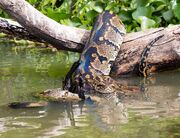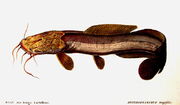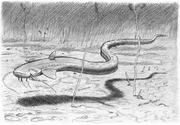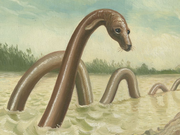| ||||||||||||||
The lukwata was a lake monster reported from Lake Victoria, which lies in Uganda, Tanzania, and Kenya. It has been reported since the turn of the 20th Century, though not in more recent times, and some cryptozoologists argue that the name has been applied to different animals, known and unknown, seen in Lake Victoria.[1][2][3] Some sightings may refer to an animal synonymous with the lau of the White Nile.[1]
Etymology[]
The etymology of the name "lukwata" is unclear. Geologist John M. Saul, who lived in Kenya, told Bernard Heuvelmans that "lukwata" was likely "look [at] water!" spoken in perfect English, an explanation which Heuvelmans found amusing, but implausible, as "lu" signifies "giant" in Ganda,[3] and "lukumbi" designates "an enormous and monstrous animal". Heuvelmans argues that the term, like chipekwe, is merely a generic word referring to a monstrous animal, and not a specific name for the cryptid.[1]
Attestations[]
The lukwata was first referenced by Church Missionary Society missionary Martin John Hall in 1898,[4] and William Arthur Crabtree (~1868 – 1945) in 1902,[5] but was not described until two years later, by Sir Harry Johnston (1858 – 1927), discoverer of the okapi.[1] According to Johnston in his work The Uganda Protectorate (1904), there were persistent rumours of a monster called the lukwata in Lake Victoria, which he believed resembled a small cetacean, a large manatee, or, most likely, a giant fish. Some locals identified the lukwata with dangerous whirlpools on the lake.[6] In 1905, traveller John Cathcart Wason (1848 – 1921) described the lukwata as a long-necked animal...[7]
| “ | ... I have been assured by testimony it is impossible to disbelieve that it appears with head and neck at least ten feet above the level of the lake.
|
” |
The Maltese adventurer and animal collector James Martin (1857 – 1924) later confirmed that a "great water serpent or reptile" was reportedly seen on or near the north shore of the lake, usually at long intervals, and was regarded with superstition by the inhabitants of the north shore.[8] Stories of the lukwata were well-known by the time of John Alfred Jordan's 1907 dingonek sighting,[8] and at the time, the dingonek allegedly shot at by Jordan was widely thought to have been the same animal as the lukwata, including by Jordan himself. According to Jordan and Charles William Hobley, shortly after the dingonek was shot, people living on the north shore of Lake Victoria made several sacrifices, as they had heard that the lukwata had been killed by a white man. However, the armour-plated, quadrupedal dingonek was described quite differently to the lukwata.[9]
In 1913, Hobley reported that the lukwata was known on the (now) Ugandan and Kenyan shores of the lake, and was said to sometimes attack canoes.[10] According to Captain William Hichens, Edward James Wayland (1888 – 1966) of the Uganda Geological Survey collected accounts of the lukwata from what is now Kenya, where he was told that the lukwata was sometimes torn apart by crocodiles, and that local people subsequently retrieved parts of its body to use as amulets, as with the lau of the White Nile. Locals also claimed that the roar of the lukwata could be heard from a distance, a trait also in accordance with the lau. Wayland claimed to have heard this roaring for himself, and also to have seen a fragment of alleged lukwata bone.[1][11]
According to naturalist Arthur Blayney Percival (1875 – 1941), writing in 1928, the lukwata had been seen by several people on Lake Victoria, including experienced steamer officers,[12] such as the crews of the Sibyl and the Winifred.[13] In More Than a Legend (1957), Constance Whyte referred to descriptions of a lau in Lake Victoria, brought back to Scotland by soldiers sent out to British East Africa during and after the Second World War.[14]
| “ | The lau is said to have a humped body up to 100 feet in length, coloured brownish above and light yellow below. The neck is long, head snake-like and described as having two 'tentacles'.
|
” |
Sightings[]
1900[]
The most famous lukwata sighting was allegedly made by English diplomat Sir Clement Lloyd Hill (1845 – 1913) in 1900, during a tour of British East Africa as Superintendent of African Protectorates. Hill never published a first-hand account, and his sighting was described by four third-party sources: Harry Johnston, Charles William Hobley, Sir Hector Duff (1872 – 1954), and Sir Henry Hesketh Bell (1864 – 1952), all of whom gave different versions, all of which were probably somewhat distorted to support their own hypotheses.[1] Johnston's account was the earliest, and the shortest, and according to Bernard Heuvelmans was probably based on hearsay:[6]
| “ | Sir Clement Hill crossing the Nyanza [lake] in 1900 on a small steam-launch was nearly capsized by some monstrous water-creature which seemed to have a large square-shaped, fish-like head.
|
” |
Charles William Hobley, a long-time administrator in British East Africa, with an interest in what are now called cryptids, gave a slightly different account of Hill's sighting in 1913.[10] Heuvelmans regarded Hobley's version as the most credible.[1]
| “ | The late Sir Clement Hill was proceeding from Kisumu to Entebbe in a steam launch some years ago, and when off Homa Mountain a beast appeared out of the water and tried to seize a native sitting on the bow of the launch. It did not succeed, and Sir Clement (who was under the awning aft) told me that he distinctly saw it some little distance behind the boat; only its head visible, it was of a roundish shape and dark in colour. He was quite certain that it was not a crocodile.
|
” |
Hector Livingston Duff, Governor of Eastern Nyasaland who had reported his own lake monster sighting, also gave a different account of Hill's sighting in African Small Chop (1932). According to Duff's version, Hill had described the animal very much like a python, moving quickly with its flat head raised high above the water. Duff writes that Hill rejected the idea that he had seen a python.[1]
Sir Henry Hesketh Bell, a colonial administrator, gave his version of the sighting in his book Witches and Fishes (1948), after stating that Hill was never a man to exaggerate. According to Bell, from no more than a quarter of a mile away...[1][15]
| “ | ... he had clearly seen emerging from the perfectly calm water a long glistening neck surmounted by a large head resembling in shape that of a lizard. He said that the neck seemed to be about four feet long, and that almost immediately after its appearance above the surface he saw a large rounded elongated mass which appeared to be the body of the creature. He also saw in the rear of the great hump the convolutions of what he took to be some sort of a tail. The animal, whatever it was, remained above the surface long enough for the native crew of the boat to recognize it as a gigantic specimen of what they called a Lokwata.
|
” |
John Alfred Jordan, the ivory poacher who claimed to have encountered the dingonek, also gave a brief alternative version of Hill's sighting, claiming that the animal had tried to climb aboard his boat.[1]
Before 1913[]
William Grant, Provincial Commissioner of Jinja on the Ugandan shore of Lake Victoria, told Hobley that his attention was once called to an animal swimming down the Napoleon Gulf, a bay in the Ugandan portion of the lake. The animal was too far away for Grant to describe.[10] W. Grant has been confused by some authors with the explorer James Augustus Grant, who died in 1892.[1]
1959 or 1960[]
Major A. J. Ward of the King's African Rifles communicated a brief description of a possible lukwata sighting, made by a director of Macalder's Mine and his wife in 1960, to Bernard Heuvelmans. According to Ward, the pair claimed to have seen a 20–30 ft (6–9 m) long humped animal from the shore of Muhuru Bay. Heuvelmans subsequently requested a personal account from the eyewitnesses, T. E. Cox and his wife, who claimed the sighting had occurred in 1959.[1]
| “ | The afformentioned serpent was seen by me in Lake Victoria (Muhuru Bay, Kenya) around 4:30 p.m., at the end of 1959. As my husband and I approached the pier of this small jetty, I saw a bizarre object coming out of the papyrus swamp (?) at the very edge of the water (the brush vegetation which borders the greater part of the lake), and moving away at a brisk pace with the vertical movement I described previously. It appeared to have a head like a "snake" ... and appeared black. It seemed to be very long, and must also have been extremely wide (in circumference). I would say, roughly speaking, that its thickness must have been that of an average thigh, perhaps two thighs pressed together (it moved with rapidity, and could be partly in and partly out of the water at the same time!). It made straight for the center of the lake, and I think it must have been resting among the papyri when we disturbed it, as the road runs right along this swamp.
|
” |
Theories[]

The large African rock python (Python sebae) is thought to have contributed to the lukwata legend (CC BY 2.0).

The largest known catfish in Africa is the vundu (Heterobranchus longifillis) of the Upper Nile (Public Domain).

It has been suggested that the lukwata may be synonymous with the lau of the White Nile, drawn by Philippe Coudray in Guide des Animaux Cachés (2009).

One lukwata sighting described an animal similar to the Lake Tanganyika monster (Ibid.).
Bernard Heuvelmans argues that the term lukwata has been applied to various different aquatic beasts within Lake Victoria, mainly large African rock pythons (Python sebae), which was also Hector Duff's preferred explanation for the Hill sighting. However, the Hill sighting itself is difficult to examine given the four conflicting second-hand accounts, and Henry Hesketh Bell's preferred explanation–based on his own version of the sighting–was a large African softshell turtle (Trionyx triunguis).[1]
Some of the lukwata's traits as described by Hichens–its rumbling and the use of its bones as amulets–were in agreement with descriptions of the White Nile's lau, a cryptid which Heuvelmans believed to be a composite of various serpentine fish, possibly including a giant catfish. Heuvelmans agreed that this version of the lukwata could be explained by a giant catfish,[16] thus supporting Harry Johnston's original favoured theory. Heuvelmans also suggested that a giant catfish could explain Hill's sighting as described by Johnston and Hobley, as a hungry catfish would be perfectly capable of snatching a man from a canoe. Alternatively, he suggests the marbled lungfish (Protopterus aethiopicus), common in Lake Victoria, as a less likely fish identity for Hill's lukwata.[1]
The Cox sighting is more anomalous. Unless it was injured, this animal could not have been any species of fish, as it was described as moving with vertical undulations, a mammalian trait among the modern vertebrates. The Cox lukwata was also some four times the size of the largest known catfish ever measured. Heuvelmans felt that this lukwata was reminiscent of the Loch Ness monster, and wondered if Cox's description could have been subconciously influenced by press accounts of that lake monster. Heuvelmans' preferred identity for the Loch Ness monster, and for many other long-necked lake monsters, was the long-necked sea serpent (Megalotaria longicollis), speculated to be a giant giraffe-necked pinniped, populations of which could have become isolated in lochs and lakes following the fall of global sea levels during the Early Holocene. However, although he identified the South African grootslang as an isolated longneck, Heuvelmans doubted that such an animal could be present in equatorial Lake Victoria, as reports are otherwise mainly restricted to the temperate zones. Heuvelmans ultimately admitted that he could not explain the Cox sighting. A similarly-vertically-undulating lake monster was also seen in Lake Tanganyika, part of a different drainage basin, that of the Congo.[1]
Further reading[]
- Heuvelmans, Bernard (1978) Les Derniers Dragons d'Afrique, Plon, ISBN 978-2259003872
Notes and references[]
- ↑ 1.00 1.01 1.02 1.03 1.04 1.05 1.06 1.07 1.08 1.09 1.10 1.11 1.12 1.13 1.14 Heuvelmans, Bernard (1978) Les Derniers Dragons d'Afrique, Plon, ISBN 978-2259003872
- ↑ Heuvelmans, Bernard (1955) On the Track of Unknown Animals, Routledge, ISBN 978-1138977525
- ↑ 3.0 3.1 Eberhart, George M. (2002) Mysterious Creatures: A Guide to Cryptozoology, ABC-CLIO, Inc., ISBN 1576072835
- ↑ Hall, Martin John (1898) Through My Spectacles in Uganda — Online
- ↑ Crabtree, William Arthur (1902) Elements of Luganda Grammar — Online
- ↑ 6.0 6.1 Johnston, Harry (1904) The Uganda Protectorate — Online
- ↑ Wason, John Cathcart (1905) East Africa and Uganda — Online
- ↑ 8.0 8.1 Bronson, Edgar Beecher (1910) Closed Territory — Online
- ↑ Heuvelmans, Bernard & Rivera, Jean-Luc & Barloy, Jean-Jacques (2007) Les Félins Encore Inconnus d’Afrique, Les Editions de l'Oeil du Sphinx, ISBN 978-2914405430
- ↑ 10.0 10.1 10.2 Hobley, C. W. "On Some Unidentified Beasts", Journal of the East Africa and Uganda Natural History Society, Vol. 6 (1913) — Online
- ↑ Hichens, William "African Mystery Beasts," Discovery: The Popular Journal of Knowledge, Vol. 18, No. 216 (December 1937) — Online (Wayback Machine)
- ↑ Percival, A. Blayney (1928) A Game Ranger On Safari
- ↑ "An African Sea Serpent Story," The Canaseraga Times (6 July 1906)
- ↑ Costello, Peter (1974) In Search of Lake Monsters, Coward, McCann & Geoghegan, 9780698106130
- ↑ Bell, Henry Hesketh (1948) Witches and Fishes — Online
- ↑ Heuvelmans, Bernard "Annotated Checklist of Apparently Unknown Animals With Which Cryptozoology Is Concerned", Cryptozoology, No. 5 (1986)
